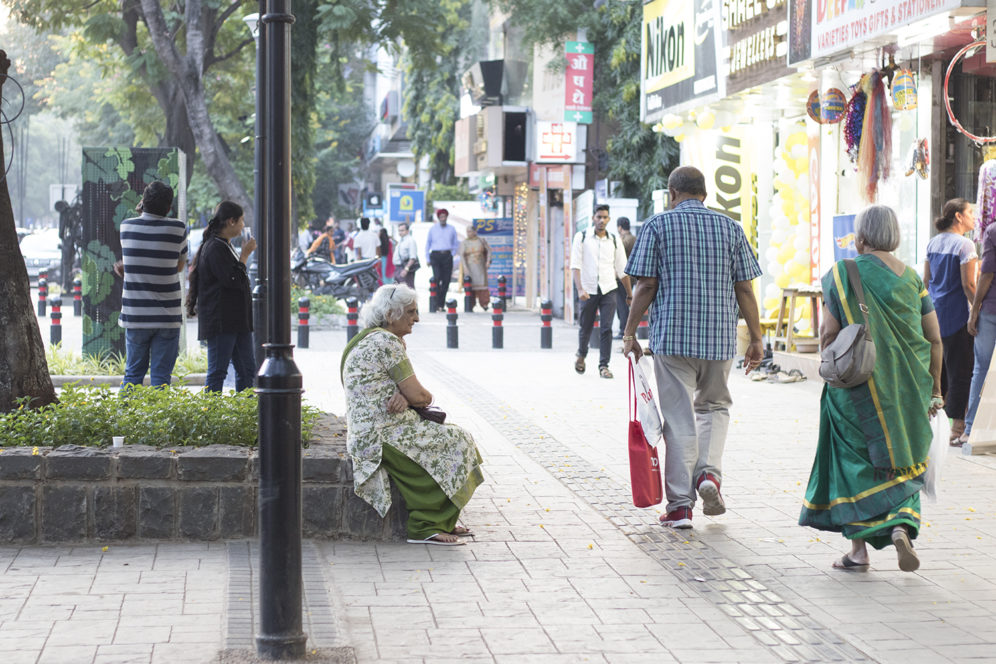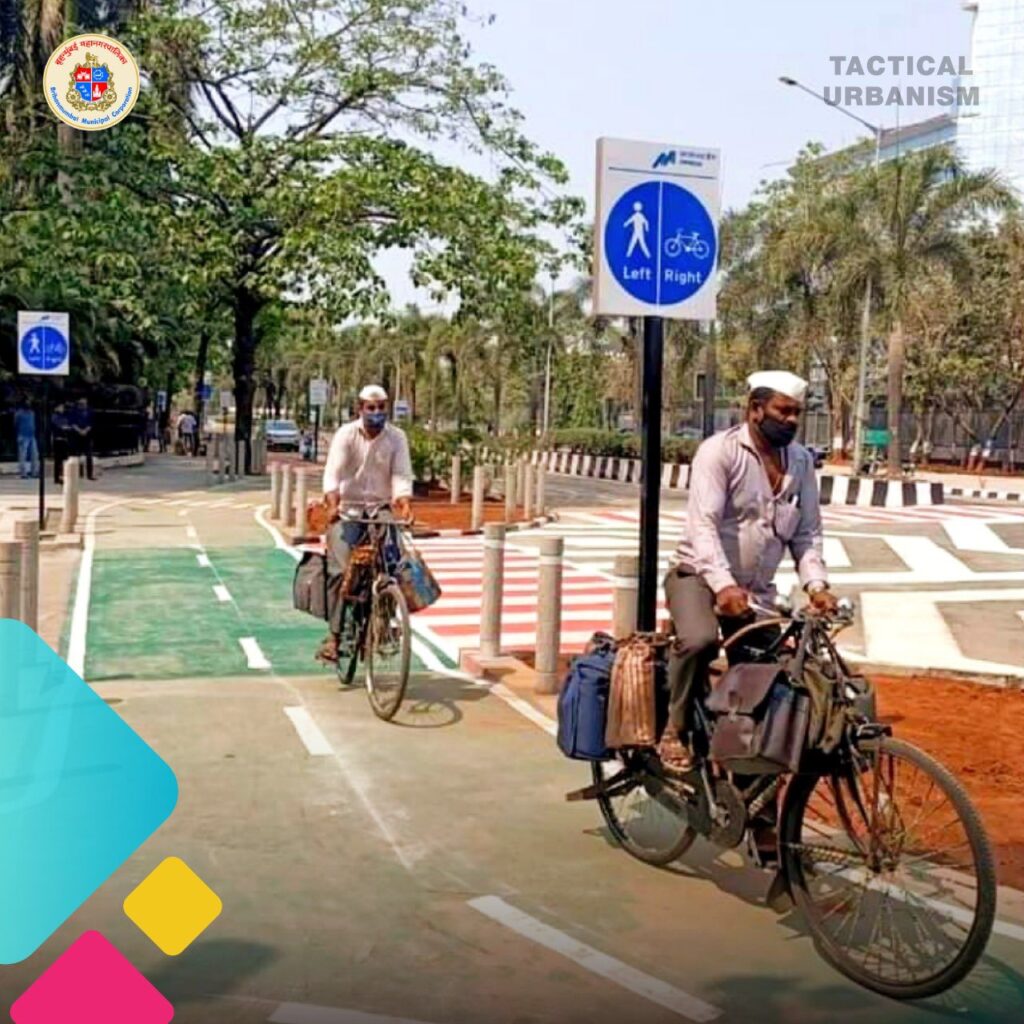
[This was a blog piece written as part of a Appreciation Course on Urban Governance by Takshashila Institution. This article relies on multiple sources for information. All the sources are credited at the end of the article]
An arterial road or an internal road. The grey colour Brihanmumbai Municipal Corporation (BMC) van arrives. A few men jump out, picking up wares from the shops on the roadside. The shopkeepers in frenzy, as if they got a premonition, have already started gathering their wares a few minutes before and stuffing it inside the shops. For a short time, a walkable road or a footpath is visible. Only for a fleeting moment. As soon as the BMC staff leaves, the shops are back. In some streets, it is the shops, while in others it is the street hawkers.
This is a scene many Mumbaikars are familiar with.
Cities should be walkable, and pedestrians have the first right is an idea well accepted across the world. In Mumbai too. Except that it continues to be in paper and in citizen’s wish list. Notwithstanding some improvements in the recent years.
Greater Mumbai, with a small land area of 458.28 sq km and a population of 12.44 million (2011 Census), has one of the highest population densities among the metropolises in the world. With limited space, high population and employment densities, traffic, transportation, housing and other civic services challenges are complex. About 51% of all trips in Mumbai are made on foot. Reports suggest that 1.5 crore people use footpaths every day in Mumbai. Even for people who travel on local trains/metro/buses, the last leg is still done on foot. Yet, walking in Mumbai could be a death trap. It is reported that pedestrians account for 47% of road accident deaths in Mumbai.
Making Mumbai walkable is a complex task. There are laws that make Brihanmumbai Municipal Corporation (BMC) legally bound to have footpaths. Section 61(m) of Mumbai Municipal Corporation Act of 1888 defines what a street is and what is expected in terms of provisions for pedestrians. The Pedestrian First Policy introduced by BMC in the year 2016 clearly articulates all the norms for footpaths. The 2023–24 BMC Budget also has earmarked funds to develop footpaths for all roads with a width of 9 m or more.
Though BMC’s road department builds footpaths, it is handed over to local wards for maintenance. But a study done by PRAJA shows that BMC’s allotment of funds to wards are a mere 15% (2023–24). This was 18% in 2021–22, showing a decline.
While there are intentions and laws, it is perhaps a long way before Mumbai becomes a pedestrian friendly city. There are two broad areas where there are multiple challenges in making this a reality. First, more roads/streets need to be covered as currently it is only select areas of the city has good footpaths, and second, existing footpaths should not be encroached up on and they should be maintained well.
Covering more areas/roads/streets: In January 2024, The Smart Cities Mission released a compendium, ‘Streets for the People: Pathways of Change from India’s Smart Cities’ documenting the learnings from 50 streetscape projects in India. The challenges faced during these projects are common to Mumbai as well. These are a) lack of long-term vision and roadmap, b) low government capacity, c) lack of political will, d) lack of coordination between multiple agencies, and e) lack of public awareness and consistent support.

Maintaining existing footpaths: While BMC has been able to gradually increase the coverage of footpaths, the problem of encroachment as well as lack of maintenance is a huge challenge.
Possible solutions: Urban systems are complex ecosystems with multiple actors and interdependencies. A challenge like ‘walkability’ cannot be seen as an isolated problem as it could be closely linked to issues like livelihoods (e.g., hawking), income inequality (e.g., slums), affordable housing (e.g., long commutes), and so on. Any short-term solution with a narrow outlook can have only limited impact. Walkability should be seen in the context of a ‘livable’ city.
Some of the possible long-term solutions will range from structural/institutional changes to behavioral changes at the community level:
- While much has been written and spoken about the constitutional provisions for making urban local bodies more autonomous, it needs to get translated to a definitive action. Mayors should become the CEO-equivalent for a city, with the right executive powers vested, rather than being a ceremonial role. Active engagement with citizens by mayor and other elected representatives will be effective only if they have enough powers to effect change. For instance, the mayor of New York City delivers an annual ‘State of the City’ speech, detailing the vision and plans for the city. As of 2024, the mayor, for the first time, has announced the appointment of a Chief Public Realms Officer, who will be responsible to improve public spaces experiences for citizens. These roles are effective only because they come with executive powers.
- As mayors get more executive powers, it is only natural that ward-level officials get a similar autonomy to prioritize issues for their wards. Master plans should ideally have year-wise plan, and that could be different for different wards. As Rishi Agarwal of the Mumbai Sustainability Centre and the Walking Project suggests, it is important to have an NMT (non-motorised transport) Cell for each ward to oversee the development and upkeep of footpaths in the city. The Hawker’s Policy should be a prerogative of local wards as the city is never a homogenous zone when it comes to the socioeconomic status.
- The BMC could leverage expertise from the community of designers, planners and architects in reimagining the public spaces in the city. The Mumbai Street Lab contest in 2019 is a great example, though it was followed by some controversies as BMC could not execute the projects. Partnering with organizations like GDCI (Global Designing Cities Initiative) is also a way for BMC to leverage expertise. GDCI has worked with some of the Indian cities as part of the Smart Cities Mission.
- Creating awareness among citizens to create demand for urban services is yet another way. The Mumbai Walking Project is an example.
- The ALM (Advanced Locality Management) introduced by BMC has isolated success stories in solving public challenges along with BMC. ALM at present is a voluntary initiative and restricted to some residential areas. Bringing business and corporate establishments in as many streets/roads as part of ALM and letting them have skin in the game might contribute positively. This could to some extent address the capacity issue.

Will all these work? If there is a cue from Tactical Urbanism initiatives from BMC, perhaps there is a ray of hope. Tactical Urbanism ‘is a way of life testing design ideas’ while carrying all the stakeholders together. Tactical Urbanism works by making changes in small, designated areas, win support from everyone and then scale up. Everyone needs an incentive and Tactical Urbanism projects perhaps can convince the stakeholders about the benefits. Tactical Urbanism will also be an opportunity for businesses and corporates to support urban make-over projects financially or otherwise. However Tactical Urbanism by itself will not solve the problem, but successful Tactical Urbanism cases can act as a catalyst for long term change.
Sources:
- Multiple articles from www.citizenmatters.in
- Streets for People: Pathways of Change from India’s Smart Cities [A compendium published by Ministry of Housing and Urban Affairs and ITDP]
- Comprehensive Mobility Plan (CMP) for Greater Mumbai – Executive Summary Report by LEA Associates South Asia Pvt Ltd.
- Pedestrian First – Footpath Policy by Municipal Corporation of Greater Mumbai
- Report on Ward Wise Budget in Mumbai – Published by PRAJA
- Tactical Thursdays Video Series by BMC [Youtube]
2 thoughts on “A Walkable Mumbai”